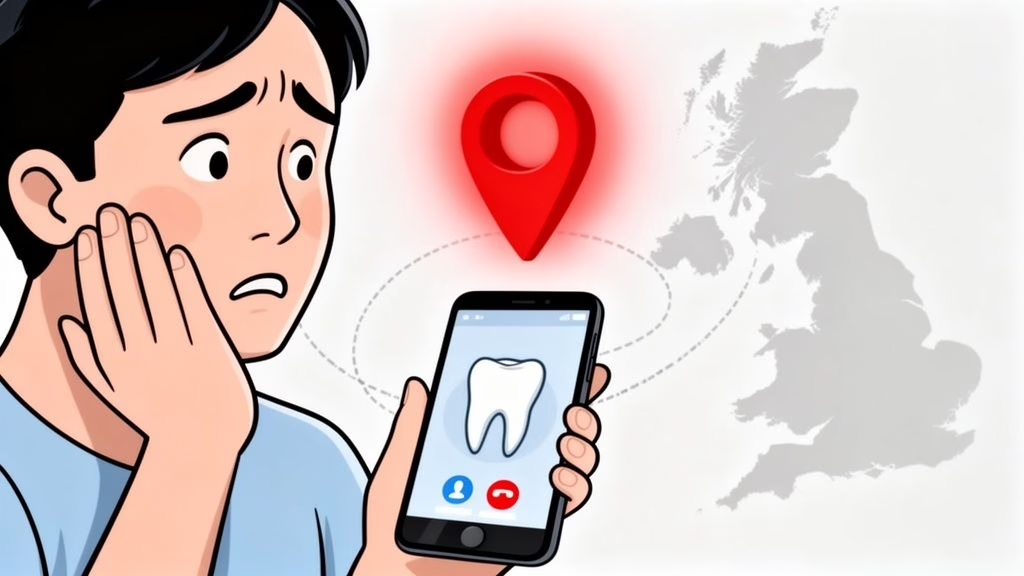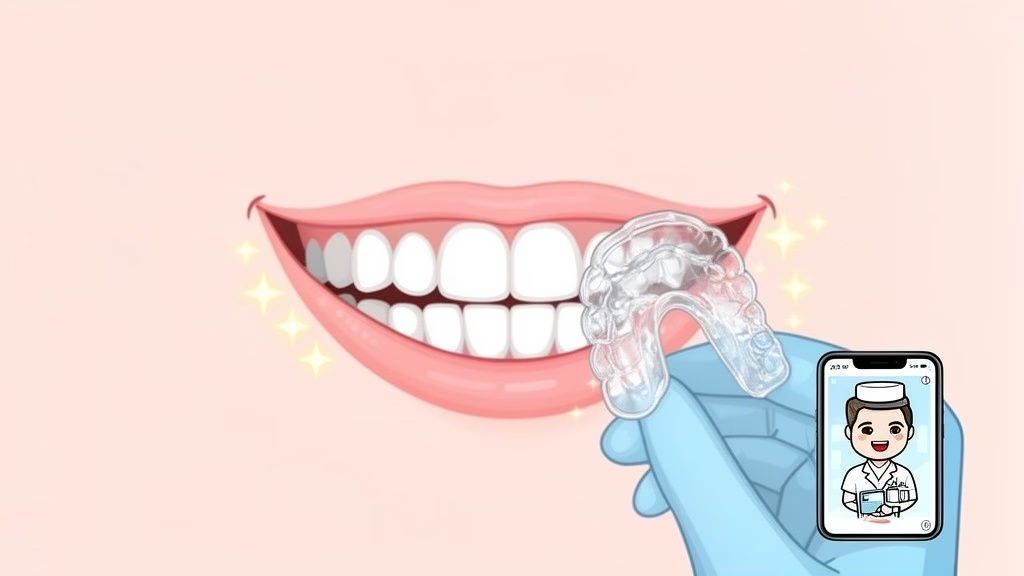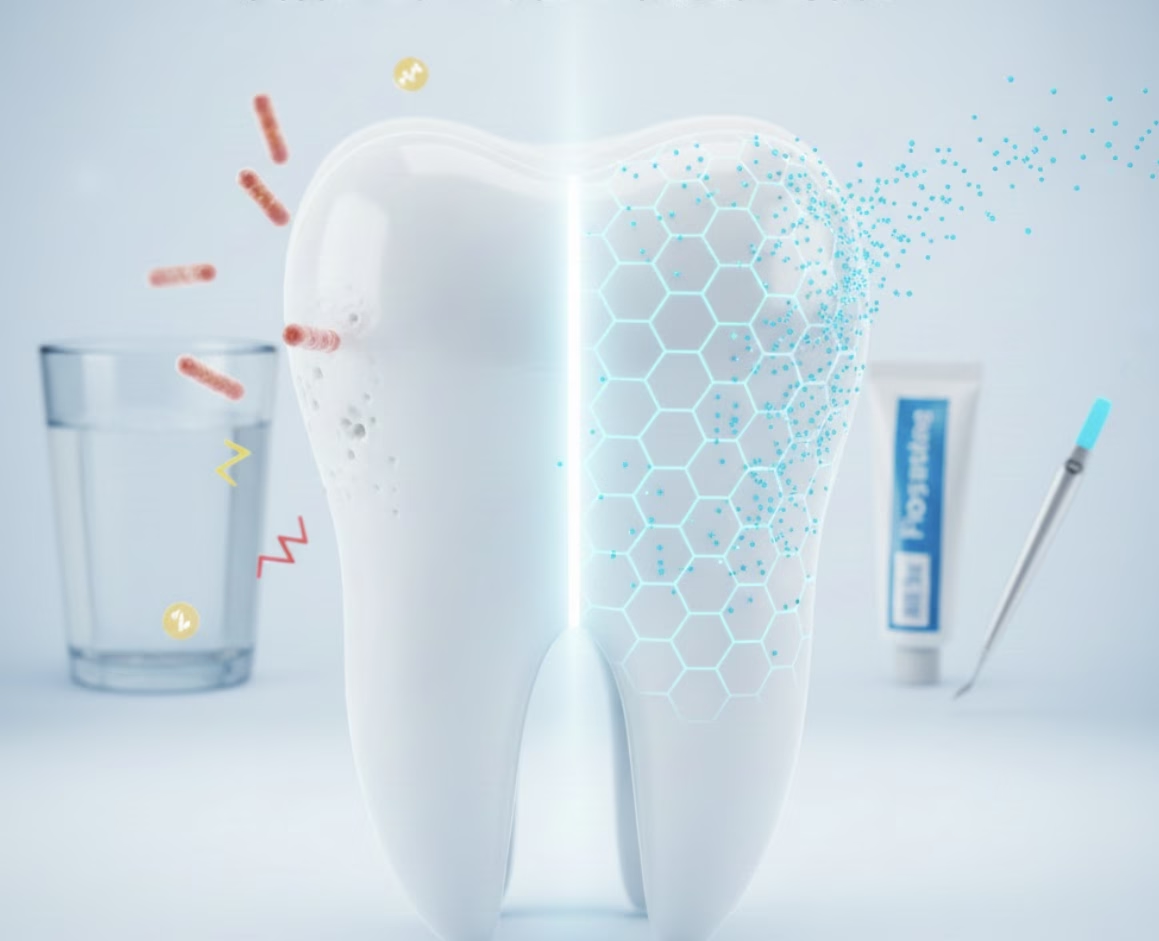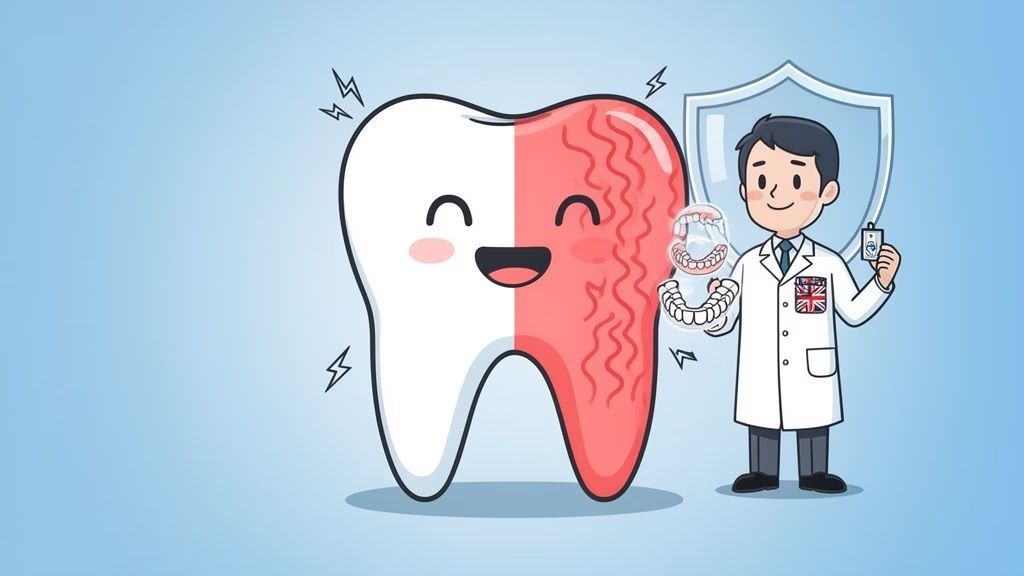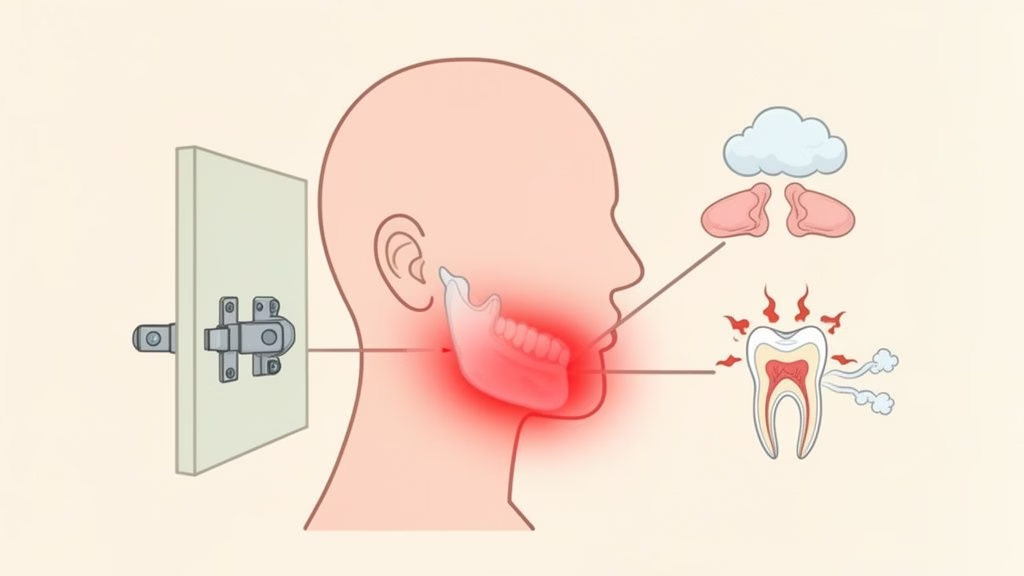What to Do Dental Emergency: UK Guide for Immediate Help
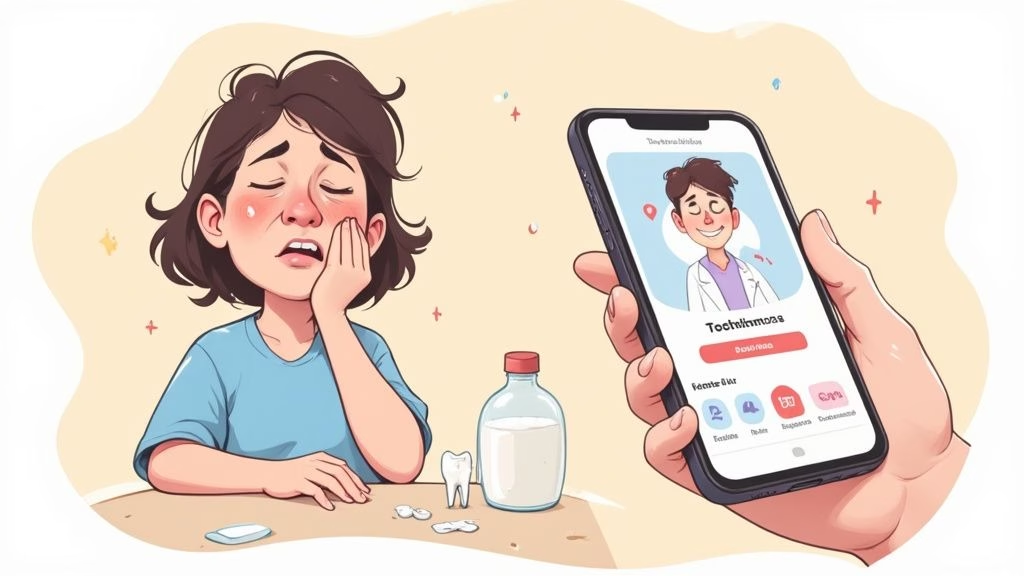
When a dental emergency hits, the last thing you want to do is panic. But let’s be realistic—seeing a tooth on the floor or feeling a sudden, sharp pain is alarming. The key is to take a deep breath and remember that what you do in the next few minutes can make a huge difference.
Your immediate goal isn’t to fix the problem yourself but to manage it. Think of it as dental triage. Simple steps like rinsing with warm salt water, using a cold compress, or correctly storing a knocked-out tooth can significantly improve the chances of a good outcome once you see a dentist.
Your First Steps in a Dental Emergency

Whether you’ve cracked a tooth on a piece of crusty bread or a filling has decided to make a sudden exit, your first reaction is probably a mix of shock and pain. It’s completely normal. The most important thing is to pause before you do anything else.
Take a moment to understand what’s happened. Is there any bleeding? Is the pain a sharp, shooting sensation, or more of a dull, persistent ache? Getting a clear picture helps you take the right first-aid steps and explain the situation accurately to a dentist.
Assessing the Situation at Home
First things first, gently rinse your mouth with warm, salty water. This is an old trick for a reason: it helps to clean the area, reduces the risk of infection, and can be surprisingly soothing for angry gums.
If you’re noticing any swelling, grab a cold compress or even a bag of frozen peas wrapped in a tea towel. Hold it against the outside of your cheek for about 20 minutes at a time. This will help bring down the inflammation and provides a bit of welcome numbness. These simple actions put you back in control and buy you crucial time to arrange professional help.
Finding Help When You Need It Most
Speaking of professional help, getting it quickly has become a real challenge here in the UK. The situation is pretty dire, with recent reports showing that around 90% of NHS dental practices aren’t taking on new adult patients. This has led to what many are calling ‘dental deserts’, where finding an emergency appointment feels almost impossible. You can explore the details of this growing dental care gap to understand just how tough it can be.
This is where thinking differently about access to care can be a game-changer. Waiting in a queue or spending hours on the phone isn’t your only option anymore.
The Toothfairy app was created for exactly these kinds of moments. It cuts through the waiting and the worry by connecting you directly to a qualified UK dentist on a video call, often within minutes. You get expert advice right when you need it, straight from your phone.
Using an app like Toothfairy means you can get a professional assessment, an e-prescription sent to your local pharmacy if needed, and a clear treatment plan without ever leaving your house. It’s also a smarter, more affordable way to handle other dental needs, like cosmetic work or getting expert advice on straightening your teeth with clear aligners, which are a popular alternative to some specific aligner brands.
When you’re faced with a sudden dental problem, it’s easy to feel overwhelmed. This quick-reference table is designed to help you instantly identify your emergency and take the correct first step, buying you precious time while you seek professional help.
Quick Guide to Dental Emergency Actions
| Emergency Type | Immediate Action | What to Avoid |
|---|---|---|
| Knocked-Out Tooth | Handle by the crown only. Rinse gently with water (no soap) and try to reinsert into the socket. If not possible, store in milk. | Don’t touch the root, don’t scrub the tooth, and don’t use tap water for long-term storage. |
| Broken/Chipped Tooth | Rinse your mouth with warm salt water. Apply a cold compress to your cheek to reduce swelling. Save any large pieces of the tooth. | Don’t use temporary filling kits on a painful tooth without consulting a dentist first. Avoid very hot or cold foods. |
| Uncontrolled Bleeding | Apply firm, steady pressure to the area with a clean gauze or cloth for 15-20 minutes. | Don’t rinse vigorously, spit, or use a straw, as this can dislodge the blood clot. |
| Severe Toothache/Pain | Rinse with warm salt water. Take over-the-counter painkillers like paracetamol (follow dosage instructions). | Don’t place aspirin directly on the tooth or gums, as it can burn the tissue. Avoid sugary or acidic foods. |
| Swelling/Abscess | Apply a cold compress to the outside of your cheek. Rinse with salt water. This is a serious issue that needs urgent attention. | Don’t ignore it, don’t apply heat to the area, and don’t try to pop or drain the abscess yourself. |
Remember, these are temporary measures to manage the situation. Your next and most important step should always be to connect with a qualified dentist for a proper diagnosis and treatment plan.
What to Do with a Knocked-Out or Broken Tooth
That sickening crunch from an olive stone, or the thud of an accidental elbow during a football match – these are moments that can end with a knocked-out or broken tooth. It’s one of the most serious dental emergencies you can face, and what you do in those first few minutes is absolutely critical.
When a tooth is knocked out completely, you’re racing against the clock. The ultimate goal is to get it back into its socket, but how you handle it can make all the difference. Always pick the tooth up by the crown, which is the white part you see when you smile. Whatever you do, don’t touch the root. The cells on the root are incredibly delicate, and they’re essential for helping the tooth reattach once it’s back in place.
If the tooth looks dirty, give it a very quick, gentle rinse under some cold water – we’re talking no more than ten seconds. Don’t use soap, and definitely don’t scrub it. If you can, gently try to slot it back into the socket. Once it’s in, you can hold it there by biting down softly on a clean piece of gauze or a handkerchief.
If You Can’t Get the Tooth Back In
Sometimes, putting the tooth back in just isn’t possible. In that case, the priority shifts to keeping it moist. The best option by far is to pop it into a small container of milk. Saliva is a decent second choice (you can hold the tooth in your cheek), but milk has the right properties to preserve those crucial root cells. Just don’t ever use tap water.
The urgency here can’t be overstated; every second really does count when you’re trying to save a tooth.

This visual guide really drives home why quick, correct action is the single most important factor in whether a damaged tooth can be saved.
For a Chipped or Broken Tooth
A chipped or broken tooth might not feel quite as dramatic as one that’s been completely knocked out, but it’s still something that needs prompt attention. A tiny chip might only be a cosmetic issue. However, a larger fracture can expose the sensitive inner pulp of the tooth, which can lead to severe pain and a high risk of infection.
Here’s a quick rundown of what to do:
- First, gently rinse your mouth with warm, salty water to help clean the area.
- If you can find any broken pieces, gather them up. Store them in milk, just like you would with a knocked-out tooth.
- To manage pain and swelling, apply a cold compress to the outside of your cheek.
- If the remaining tooth has a sharp edge, you can temporarily cover it with a bit of sugar-free chewing gum or dental wax to protect your tongue and cheek.
It’s tempting to ignore a small chip, but please don’t. Even minor-looking damage can hide deeper structural problems. Leaving it can turn what would have been a simple fix into a much more complicated and expensive procedure down the line.
Whether the tooth is broken or completely out, your very next move should be to get professional advice straight away. An app like Toothfairy is a brilliant way to connect with a UK-based dentist almost instantly. They can assess the situation through a video call, tell you if you need to be seen in person, and give you that crucial peace of mind when you’re feeling panicked. Toothfairy provides a smarter and more affordable way to explore cosmetic options too, like straightening your teeth with clear aligners, a far cry from old-school metal braces.
What to Do for a Severe Toothache or a Suspected Abscess

There are few pains as all-consuming as a severe, throbbing toothache. It’s not just a minor annoyance; it’s your body screaming that something is seriously wrong inside your mouth. We’ve all had a twinge from a cold drink, but a relentless ache that keeps you up at night or makes it impossible to focus is a different beast entirely.
This level of intense, persistent pain is often a red flag for an infection deep within the tooth, which can lead to a dental abscess. An abscess is essentially a pocket of pus that forms at the tooth’s root or in the surrounding gum tissue. It’s a serious condition that absolutely cannot be ignored, as the infection can potentially spread elsewhere in your body.
Is It an Abscess? Key Signs to Look For
So, how do you know if that agonising toothache has escalated into an abscess? From my experience, there are a few classic symptoms that point to this being a true dental emergency.
- A deep, throbbing pain: This isn’t just a sharp pain; it’s a constant, severe ache that might even radiate into your jaw, neck, or ear.
- A “pimple” on your gum: You may see or feel a small, tender bump on your gum line near the source of the pain.
- Swelling in your face: If your cheek or jaw has started to swell up and feels tender, that’s a major warning sign.
- Feeling generally unwell: A spreading infection can make you feel run-down, and you might even develop a fever.
If you’re experiencing any of these, particularly facial swelling or a fever, you need to seek professional dental advice immediately.
How to Manage the Pain Safely at Home
While you’re arranging to speak with a dentist, a few simple measures can help you cope with the discomfort. Gently rinsing your mouth with a warm salt water solution (about half a teaspoon of salt in a glass of warm water) can soothe the area and help keep it clean. Applying a cold compress to the outside of your cheek can also bring down some of the swelling and numb the pain.
What you don’t do is just as important. Never, ever put an aspirin directly on your tooth or gum; it’s acidic and can cause a painful chemical burn to your delicate mouth tissues. And please, don’t try to pop or drain an abscess yourself. This can easily make the infection much worse.
Key Takeaway: An abscess will not heal on its own. Your top priority must be getting a professional diagnosis, as an untreated infection can lead to serious, system-wide health problems.
It’s a stark reminder of how common these situations are. Recent NHS dental records in England revealed that out of 35 million courses of treatment, a full 10% were for urgent care. That’s a huge number of people dealing with the same kind of pain and worry you might be feeling right now. You can see the full breakdown of these dental care statistics from the NHS Business Services Authority.
The thought of waiting for an appointment in this state is unbearable. This is precisely where the Toothfairy app becomes a lifeline. Instead of waiting, you can have a video call with a qualified UK dentist, often within minutes. They can assess your situation, provide a diagnosis, and, if needed, send an e-prescription for antibiotics or strong painkillers directly to your local pharmacy.
What to Do with Lost Fillings, Crowns, and Bleeding
That strange, hard crunch in the middle of a meal is a uniquely jarring experience. You suddenly feel a gap where a filling used to be. Losing a filling or a crown instantly exposes the sensitive, vulnerable part of your tooth, and it often brings on a sharp, zinging pain and a serious risk of more damage.
The bit of your tooth that’s now exposed is called dentine, and it’s much softer than the tough outer enamel. If you leave it unprotected, you’re looking at severe sensitivity, a nasty infection, or even a fracture of what’s left of the tooth. Your first priority has to be covering that spot up until you can get proper help.
Temporary Fixes for a Lost Filling or Crown
A quick trip to a local pharmacy for a tube of temporary dental cement can be an absolute lifesaver in this situation. It’s designed to be a short-term fix, letting you seal the cavity or re-seat a crown yourself for a little while. This simple step can drastically reduce that painful sensitivity to air and temperature and keeps food from getting packed in.
What if a whole crown has come off? If it looks to be in one piece, put it somewhere safe immediately. Whatever you do, don’t even think about using superglue or any other household adhesive to stick it back on. A dentist can often clean and re-cement the original crown, which is always the best and most cost-effective outcome.
Here’s a quick rundown of what to do:
- First, gently rinse your mouth with some warm salt water to clean the area.
- Next, follow the instructions on the temporary cement packet to carefully fill the cavity.
- If it’s a crown, clean it gently and pop it in a small, secure container to bring with you.
A temporary filling is exactly what it sounds like—temporary. It is absolutely not a substitute for seeing a dentist. Think of it as a plaster to get you through until you can get a proper professional repair.
How to Manage Bleeding That Won’t Stop
Seeing a lot of blood after an injury or a tooth extraction can be pretty alarming, but you can usually get it under control at home. The secret is applying firm, consistent pressure directly to the source.
Take a sterile piece of gauze, fold it into a thick pad, place it right over the bleeding area, and bite down hard. You need to keep that pressure on, without letting up, for a solid 15-20 minutes. Resist the temptation to peek every few minutes; doing so will just dislodge the fragile clot that’s trying to form and start the bleeding all over again.
If the bleeding is heavy and shows no sign of slowing after 20 minutes of sustained pressure, the situation has become a serious dental emergency. This is your cue to get professional help immediately.
But instead of heading straight to A&E, where they are rarely equipped to handle specific dental problems, a much faster and more effective move is to connect with an expert through the Toothfairy app. A qualified UK dentist can assess everything on a video call, figure out what’s causing the bleeding, and tell you exactly what to do next. It’s simply a smarter, less stressful way to handle a difficult situation.
How Do You Find an Urgent Dentist in the UK?
Knowing the right first aid for a dental emergency is a huge help, but it’s only half the battle. The other, often much harder, part is actually getting to see a dentist who can help you quickly. When you’re in pain and feeling stressed, trying to navigate the UK’s strained dental system can feel like an impossible task.
The unfortunate reality is that getting an urgent NHS appointment has become incredibly difficult for many. We hear a lot about ‘dental deserts’—entire regions where practices have simply stopped taking on new NHS patients. This can lead to hours spent on the phone, endless waiting lists, and a feeling of being completely stuck with nowhere to turn.
The Challenge of Finding an NHS Dentist
This isn’t just a minor inconvenience; the scale of the access issue is huge. A recent GP Patient Survey actually found that around 25% of patients who tried to see an NHS dentist in the last two years couldn’t get an appointment at all.
While the government has promised to create an extra 700,000 urgent appointments in England to tackle this crisis, the immediate need on the ground often outstrips what’s available. You can read more about the government’s plan to expand urgent dental care for the full picture.
For anyone going through a dental emergency, this situation just adds another layer of anxiety to an already painful problem. Spending your morning calling different practices only to be told they have no slots is a common and demoralising experience. It’s this exact challenge that has shown us we need a smarter, more direct way to get professional dental help.
A Modern Solution to an Old Problem
This is where a service like the Toothfairy app offers a genuine lifeline. Instead of getting stuck in traditional, often overloaded, appointment systems, you can bypass the queues and uncertainty completely. The app was built specifically to bridge this gap, connecting you directly with a UK-based, GDC-registered dentist through a secure video consultation.
Imagine you’ve just lost a crown. Instead of starting a frantic Google search for a local practice that might be open, you can simply open the app. Within minutes, you could be speaking face-to-face with a professional who can assess the damage, give you immediate advice, and create a clear plan of action.
This isn’t just about convenience; it’s about getting timely, professional care right when you need it most. An expert on video can quickly figure out how urgent your situation is, prescribe necessary medications like antibiotics or painkillers, and even refer you for in-person treatment if it’s required.
This approach completely changes the experience of handling a dental emergency. It takes away the stress of the unknown and puts expert guidance right at your fingertips. It’s also a smarter and more affordable way to get other dental work sorted, like cosmetic treatments or teeth straightening with clear aligners, which are a popular, discreet alternative to some specific aligner brands.
To put it into perspective, here’s a simple comparison showing how using an app differs from the traditional routes for finding urgent care.
Comparing Emergency Dental Care Options
| Feature | Traditional NHS/Private Route | Using the Toothfairy App |
|---|---|---|
| Accessibility | Can involve long waits on the phone and a real struggle to find an available appointment. | Connect with a UK-based dentist via video call, often within minutes, 24/7. |
| Speed of Diagnosis | You have to wait until your in-person appointment time, which could be hours or even days away. | Get an immediate professional assessment, diagnosis, and treatment plan during your call. |
| Prescriptions | Requires an in-person visit to a dentist before any prescription can be issued. | E-prescriptions for painkillers or antibiotics can be sent straight to your local pharmacy. |
| Cost | NHS has a set fee (if you can find a slot). Private fees are often high and unpredictable for emergencies. | Offers a clear, affordable fee for the initial virtual consultation and any follow-up care. |
| Convenience | Requires travelling to a clinic, often while in significant pain and discomfort. | Access expert dental care from the comfort of your home, office, or wherever you happen to be. |
When you’re trying to decide what to do in a dental emergency, having a reliable, fast, and accessible option really does make all the difference.
Your Dental Emergency Questions Answered
When you’re faced with a sudden dental problem, your mind starts racing. It’s stressful, and knowing what to do can make all the difference. Let’s walk through some of the most common questions that pop up when you’re in the thick of it.
“Should I Go Straight to A&E?”
It’s a natural first thought for any emergency, but for dental issues, A&E is almost never the right place. Hospital emergency departments aren’t set up for dental care. They can give you painkillers, but they can’t perform a root canal or fix a broken crown.
There are, however, a few critical exceptions. You absolutely should go to A&E if you experience:
- Bleeding that won’t stop. If you’ve applied firm pressure for 20 minutes and it’s still bleeding heavily, that’s a sign you need urgent medical help.
- Severe facial swelling that’s making it difficult to breathe, swallow, or see properly.
- A serious injury to your face, jaw, or head from an accident.
For everything else – the agonizing toothache, the snapped tooth, the lost filling – you need a dentist.
“How Much Will an Emergency Appointment Cost Me?”
This is a huge source of anxiety for many people. In the UK, the cost can be all over the map. An urgent NHS appointment has a fixed charge, but as anyone who’s tried to find one knows, they are incredibly hard to come by.
Turning to a private clinic often feels like the only option, but a last-minute appointment can set you back over £100 for the consultation alone. That’s before they’ve even started any treatment, leaving you with a potentially huge and unexpected bill.
That’s where an app like Toothfairy can be a real game-changer. It sidesteps the whole problem by offering a straightforward, affordable fee for a video call with a qualified UK dentist. You get expert advice immediately, without the guesswork and financial worry of an in-person private appointment.
“What Should I Keep in a Dental First-Aid Kit?”
A little bit of preparation goes a long way. Having a dedicated dental first-aid kit at home is one of the smartest things you can do. You don’t need a lot, just a few key items to handle the immediate aftermath of a problem.
Here’s what I’d recommend putting in yours:
- A few sterile gauze pads to help manage any bleeding.
- A small, clean container with a lid – absolutely essential for storing a knocked-out tooth safely.
- Your preferred over-the-counter painkillers (paracetamol or ibuprofen).
- A small pot of temporary filling material from a pharmacy. It’s brilliant for covering a sensitive, exposed nerve.
With these basics on hand, you can confidently manage the situation and protect your teeth while you arrange to speak with a professional.
When a dental emergency hits, the last thing you need is more stress. With Toothfairy, you can skip the frantic searching and connect directly with a qualified UK dentist via a secure video call. Get professional advice, a diagnosis, or even a prescription sent to your local pharmacy in minutes. To learn more about smarter, more affordable solutions for everything from urgent care to teeth straightening and cosmetic work, visit Toothfairy.
Last updated on September 8, 2025

Toothfairy Care Team
Toothfairy, is the world's smartest dental app, that connects patients to a dentist for a range of issues, from emergencies, cosmetics, prescriptions to virtual exams.
Toothfairy Care Team
Toothfairy, is the world's smartest dental app, that connects patients to a dentist for a range of issues, from emergencies, cosmetics, prescriptions to virtual exams.
